Whether you’re completely new to playing the electric guitar, or have just purchased a new model, getting to grips with the controls should be at the top of your priorities. Different guitars have different controls, knobs and switches, making it a little confusing, so I’ve written this guide to take you through everything you need to know.
The Quick Answer
Most electric guitars have at least 3 controls: a pickup selector, volume control and tone control. The pickup selector which allows you to activate the pickups in isolation to achieve different tones. The tone knob allows you to adjust how bright or warm the pickups sound.
Here is the contents of this article:
- Basic Controls
- Controls on Popular Electric Guitar Models
- Advanced Controls
The Basic Controls
Some guitars only have one pickup, in which case the controls are very simple, but the vast majority will have either two or three pickups.
The pickups are responsible for sending a signal to your amplifier, to produce the sound. You can use your amplifier to change the tone and the level of distortion, but your pickups play a huge role in creating the overall tone. This is why most electric guitars have several controls to adjust the signal that the pickups send to your amplifier.
There are many different types of pickups, and I won’t go into all the differences here, as this article is focused on the guitar’s controls. But if you want to learn more, then check out my ultimate guide to pickups for everything you need to know.

There are three main controls found on an electric guitar:
- Pickup Selector
- Tone Control
- Volume Control
Let’s take a look at each of them individually.
Pickup Selector
On electric guitars with two or more pickups, you will have a pickup selector. This is used to activate certain pickups, to produce different tones.
The position of the pickup affects the tone produced. Pickups located closer to the bridge of the guitar, sound bright and punchy, whereas pickups located closer to the neck of the guitar sound more mellow and warm.
Often, the bridge pickup is used for lead playing, or when using high gain amp settings, because it allows the sound of the guitar to cut through the rest of the band. Whereas the neck pickup often is used for rhythm playing and clean tones, to avoid the sound being too aggressive.
Pickup selectors come in a variety of shapes and sizes. They can be located on the upper or lower section of the guitar, it depends on the model, but they are usually pretty easy to spot. Here are some examples.

On guitars with two pickups, you’ll usually find a 3-way pickup selector. This means there are three possible positions the switch can be in.
- Bridge pickup only
- Both pickups together
- Neck pickup only
On pickup selectors which move sideways rather than up and down, the location will indicate which pickup is active. For example, if it is closest to the bridge, then it will activate the bridge pickup. On selectors which move up and down, the down position is usually the bridge pickup and the up position is usually the neck pickup.
You’ll be able to hear the differences as well. The most mellow sounding selection will be the neck pickup and the brightest will be the bridge pickup.
On guitars with 3 pickups, you’ll likely find a 5-way pickup selector which will have the following combinations
- Bridge pickup only
- Bridge pickup and middle pickup together
- Middle pickup only
- Middle pickup and neck pickup together
- Neck pickup only
The pickup selector is often the most useful control on the guitar, as it allows you to easily transition from lead to rhythm playing, or bright to mellow tones and back, without touching your amplifier.
Volume and Tone Controls
Pretty much every electric guitar will have at least one of these controls, no matter if it has one, two or three pickups in it. Here’s what they do:
- Tone control: this adjusts the treble (high-end) frequencies. Turning the control down, reduces the treble, causing the tone to sound warmer and less crisp and clear. Keeping it on full, will ensure the maximum treble output.
- Volume control: this adjusts how loud the pickup is. It also limits the treble frequencies if you turn it down, so can have the effect of making the tone a bit more mellow as well as impacting the volume.
I usually keep these controls on full for my guitar as I prefer to adjust the tone and volume using my amplifier, but have a play around with them and see what tones you like.
Things can get a bit complicated when the guitar has multiple tone and volume controls. Some guitars such as the Les Paul, actually have a tone and volume control for each pickup. I’ll go through some popular guitars and their controls in the next section, but here are some tips to help figure out which is which.
- Use the pickup selector to activate one pickup on its own e.g. the bridge pickup.
- Turn all the knobs up to maximum.
- Turn one of the knobs off completely and then play the guitar. If there is no sound, then this is a volume control.
- Then select the neck pickup only, and turn the same knob off. If there is no sound, then the volume control adjusts BOTH pickups. If the guitar still is playing through the amp, then the knob was a BRIDGE VOLUME control. The opposite would be true if the knob only affect the neck pickup, indicating that it was a NECK VOLUME control.
- Once you’ve identified the volume knob/ knobs, then you can figure out the tone controls.
- Use the pickup selector to activate one pickup on its own e.g. the bridge pickup and turn the volume control and the other knobs to maximum.
- Decrease the mystery control, if the tone sounds more mellow, this is a BRIDGE TONE CONTROL.
- If there is no change, select the neck pickup on it’s own and decrease the control again. This time, it should make the guitar sound more mellow, indicating that it’s a NECK TONE CONTROL.
Some guitars have two volume controls, and one tone control, others have two tone controls and one volume control. But you can use the process above to figure out what everything is doing. The key is to find the volume controls first!
If you really want to improve your guitar playing then I recommend checking out Guitareo. You can sign up for a free 30-day trial here to get access to all the online lessons and start making real progress today
Examples of Popular Electric Guitar Models
Before we move onto some more advanced controls which are usually found on more obscure models and versions, I wanted to take a look at some popular models and highlight the different controls and their functions. I also have individual guides for each of these guitars linked in the relevant sections which have some great bonus tips.
Stratocaster
- 3 pickups
- 5-way pickup selector
- 1 volume control
- 2 tone controls
Since this guitar has three pickups, pretty much every model has a 5-way pickup selector, except the entry level Squier version which has a 3-way pickup selector (bridge only, middle only and neck only).
Most models have three knobs:
- Volume
- Tone 1: adjusts the neck pickup
- Tone 2: adjusts the middle pickup
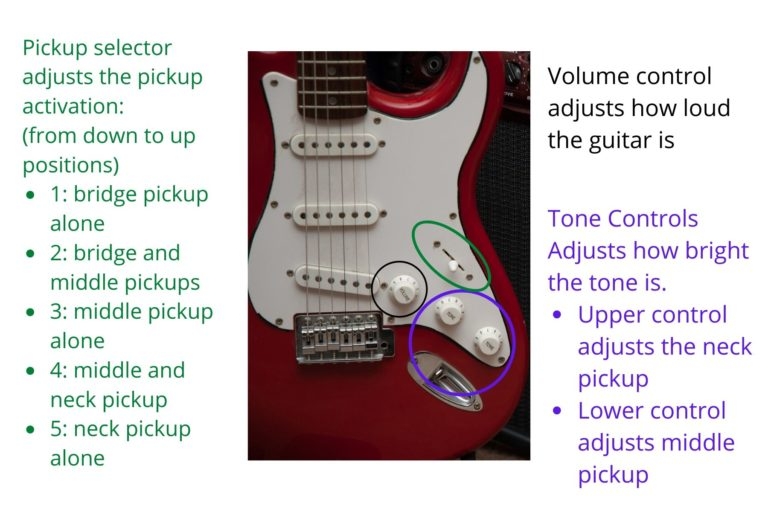
Check out my full guide to using a Stratocaster’s controls to learn more tips to get the best tone.
Les Paul and SG
- 2 pickups
- 3-way pickup selector
- Tone control for each pickup
- Volume control for each pickup
These two iconic guitars use the same controls which are quite unique, in that each pickup has independent volume and tone controls. This allows you to set up independent lead and rhythm tones, and then use the pickup selector to quickly flick between them.
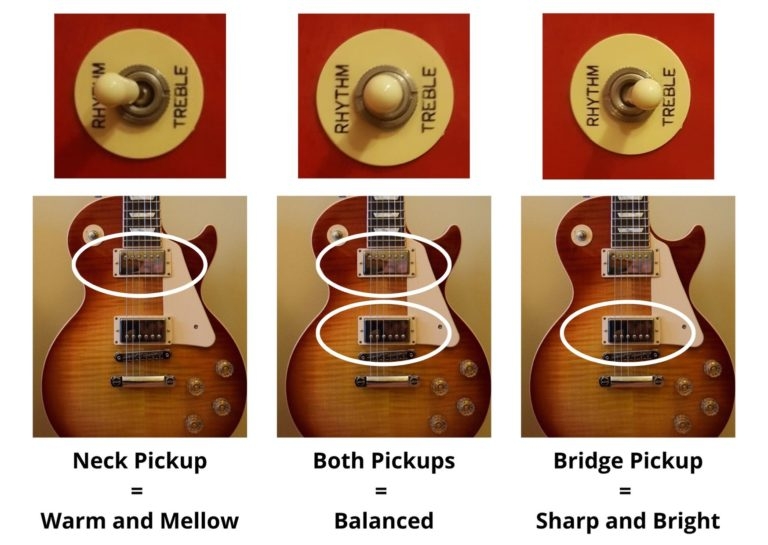
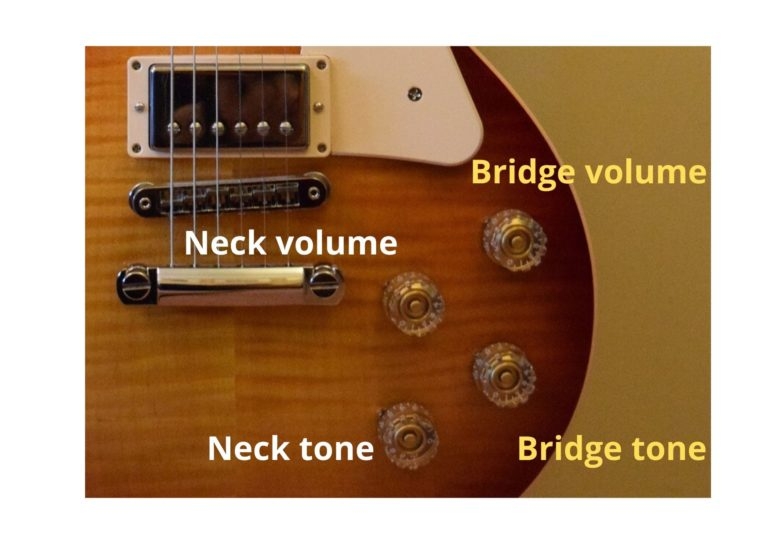
Check out my guide to using a Les Paul and my guide to using an SG to learn how to create unique tones and get the most out of these models.
Telecaster
- 2 pickups
- 3-way pickup selector
- 1 tone control
- 1 volume control
The Telecaster is one of the easiest guitars to use. The 3-way pickup selector allows you to activate the bridge and neck pickup in isolation, or together, and the tone and volume controls adjust both pickups.
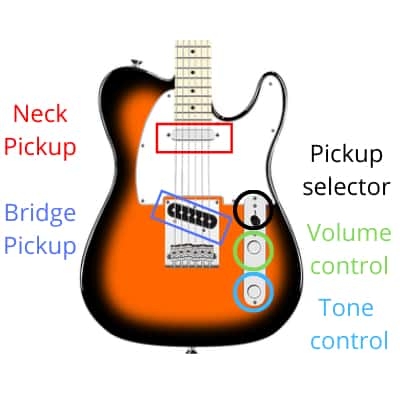
Check out my complete guide to the Telecaster electric guitar’s controls.
Jazzmaster
- Two pickups
- Rhythm/ lead switch
- Rhythm tone and volume controls
- Master tone and volume controls
- 3-way pickup selector
The Jazzmaster is a pretty confusing guitar, not only because the controls are complicated, but also because they are different on every model!
I’ve written a full guide to using every model of Jazzmaster here, and I strongly recommend checking it out if you own one, so you know exactly what the knobs on your guitar do.
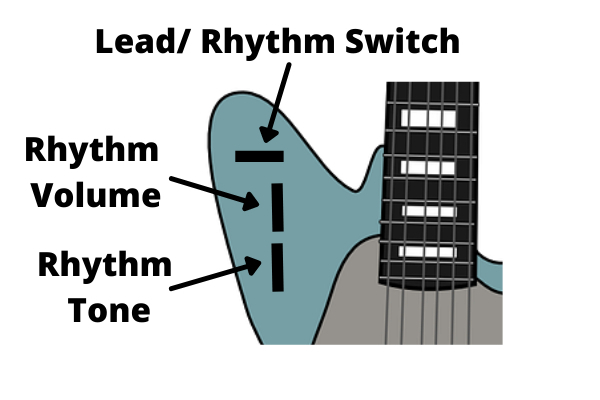

Jaguar
- Two pickups
- Lead/ rhythm switch
- Rhythm tone and volume controls
- Master tone and volume controls
- Tone cut switch
- Bridge pickup on/off
- Neck pickup on/off
The Jaguar also has a very complicated set of controls which varies depending on which model is in questions. I’ve written an in-depth guide explaining the controls of every Jaguar model by Fender and Squier to help clear everything up.
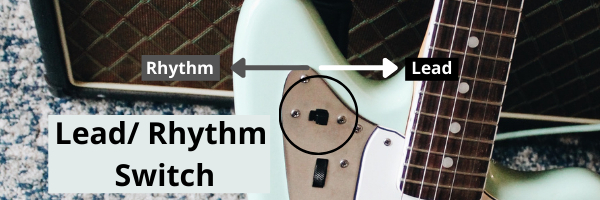
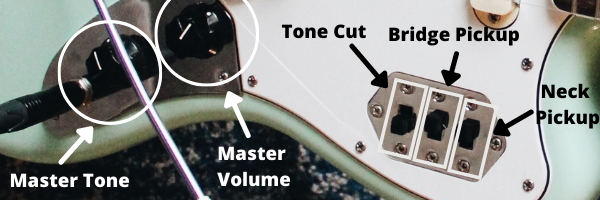
More Advanced Controls
So we’ve been through some specific examples of guitars and how their controls work, but the story doesn’t end here. There are so many models and variations out there, which means, you guessed it, more controls.
We’ve touched on the Jaguar and Jazzmaster controls and their rhythm/ lead switches, so I recommend checking out those articles linked above as I won’t go through them again here.
Here are the controls I’ll go through in this section:
- Coil split/ tap
- Phase/ parallel switching
- Piezo pickup activation
Coil Splitting and Tapping
This is a common feature seen on electric guitars with humbucker pickups. Humbuckers naturally sound warm and full in comparison to single coil pickups, which sound brighter and thinner. The coil split/ tap function, allows you to make the humbuckers in your guitar, sound more like single coils with one easy motion.
They won’t sound exactly like single coils though, but it’s a very useful feature to have which gives your guitar way more functionality and versatility.
Usually, this switch is located in the tone control. By pulling it upwards you split/ tap the humbuckers to make them sound like single coils, and pushing it downwards will cause them to return to their natural humbucker form.
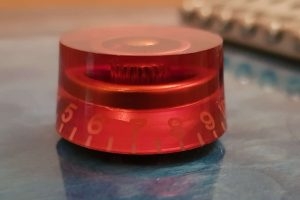
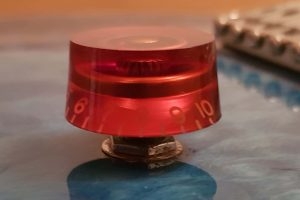
Phase/ Parallel Switching
This is found on some Fender Mustangs and Jazzmasters, as well as on other brands.
In most cases, the phase/ parallel switching comes in the form of a switch for each pickup. Here’s how they usually function:
- When both switches are pointing in the same direction, both pickups are parallel and in-phase, which gives the guitar a fuller sound.
- When the switches are pointing in opposite directions, the out of phase, which cuts the bass-frequencies, causing the tone to sound thin and crisp.
Sometimes, this feature can be built into the pickup selector instead. For example, if the guitar has a 5-way pickup selector but only 2 pickups, then positions 2 and 4 are often used to make the pickups “out of phase”.
Piezo Pickup Activation
Some electric guitars have piezo pickups located in the bridge of the guitar which allow you to achieve a more acoustic tone, which sounds quite different to regular magnetic pickups. This is a rare feature, but can be seen on guitars by some brands such as ESP and PRS.
Guitars with this feature usually have an additional switch on the body which allows you to select either the magnetic or the piezo pickups.
Here are some more articles you might find useful:

Yes, you leave your volume and tone up all the way because they don’t work. They don’t adjust the volumne or tone. Could you imagine your volume and tone controls on your radio or sterio working the way the volume and tone controls on most guitars work? You’d through the thing into the trash.
I’m devoted to onboarding true controls into the electric guitars.